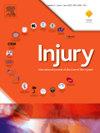2084例Lisfranc损伤的流行病学、分类和治疗:来自瑞典骨折登记的观察性研究
IF 2.2
3区 医学
Q3 CRITICAL CARE MEDICINE
Injury-International Journal of the Care of the Injured
Pub Date : 2024-11-22
DOI:10.1016/j.injury.2024.112036
引用次数: 0
摘要
背景:lisfranc损伤可能很严重,但相对罕见。关于中足Lisfranc损伤的流行病学数据有限。本研究旨在描述损伤的流行病学、损伤机制和主要治疗方法。方法一项观察性登记研究检查了2013年至2022年在瑞典骨折登记中登记的所有Lisfranc损伤。对患者的性别、年龄、受伤日期、受伤类型、受伤机制和主要治疗进行分析。结果共纳入2079例患者中2084例Lisfranc损伤,其中男性占54%。男性平均受伤年龄为43岁(18-92岁,SD 17.3),女性平均受伤年龄为49岁(18-96岁,SD 17.4)。5例中有1例是由高能外伤引起的,最常见的损伤机制是简单的绊倒(31%)。大约39%的患者接受手术治疗,使用钢板固定(51%)是主要的治疗选择。11%的手术治疗病例进行了原发性关节融合术。结论骶髂关节损伤是多种损伤机制的结果,主要由低能损伤引起,在所有年龄组的成年人中都有发现。大多数Lisfranc损伤采用非手术治疗。这种理解有助于在日常临床实践中准确诊断和管理。本文章由计算机程序翻译,如有差异,请以英文原文为准。
Epidemiology, classification, and treatment of 2084 Lisfranc injuries: An observational study from the Swedish fracture register
Background
Lisfranc injuries are potentially severe but relatively uncommon. Limited epidemiological data regarding Lisfranc injuries of the midfoot are available. This study aimed to describe the injury's epidemiology, injury mechanism, and primary treatment.
Methods
An observational register study examined all Lisfranc injuries registered in the Swedish Fracture Register from 2013 to 2022. Data on sex, age, date of injury, injury type, injury mechanism, and primary treatment were analysed.
Results
Some 2084 Lisfranc injuries in 2079 patients (54 % men) were included in the study. The mean age at injury was 43 (18–92, SD 17.3) years for men and 49 (18–96, SD 17.4) for women. One of five cases were caused by high-energy trauma, and the most common injury mechanism was a simple fall - tripping (31 %). Approximately 39 % of patients underwent operative treatment, with fixation using plates (51 %) being the prevailing choice of treatment. Primary arthrodesis was performed in 11 % of the operatively treated cases.
Conclusions
Lisfranc injuries are the consequence of a broad spectrum of injury mechanisms, are primarily induced by low-energy trauma and found in all age groups in adults. The majority of Lisfranc injuries are treated non-operatively. This comprehension can aid in accurate diagnosis and management in everyday clinical practice.
求助全文
通过发布文献求助,成功后即可免费获取论文全文。
去求助
来源期刊
CiteScore
4.00
自引率
8.00%
发文量
699
审稿时长
96 days
期刊介绍:
Injury was founded in 1969 and is an international journal dealing with all aspects of trauma care and accident surgery. Our primary aim is to facilitate the exchange of ideas, techniques and information among all members of the trauma team.

 求助内容:
求助内容: 应助结果提醒方式:
应助结果提醒方式:


